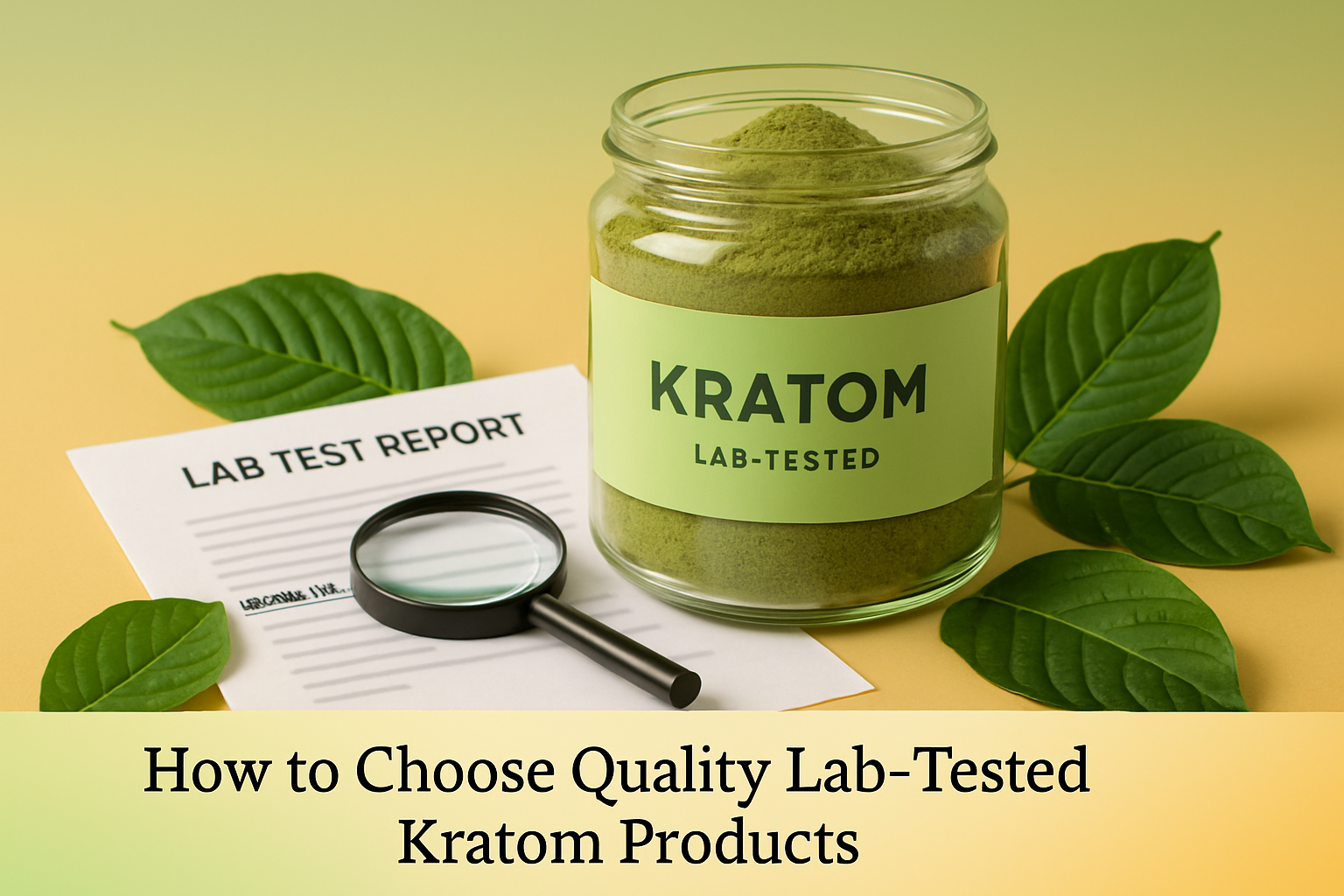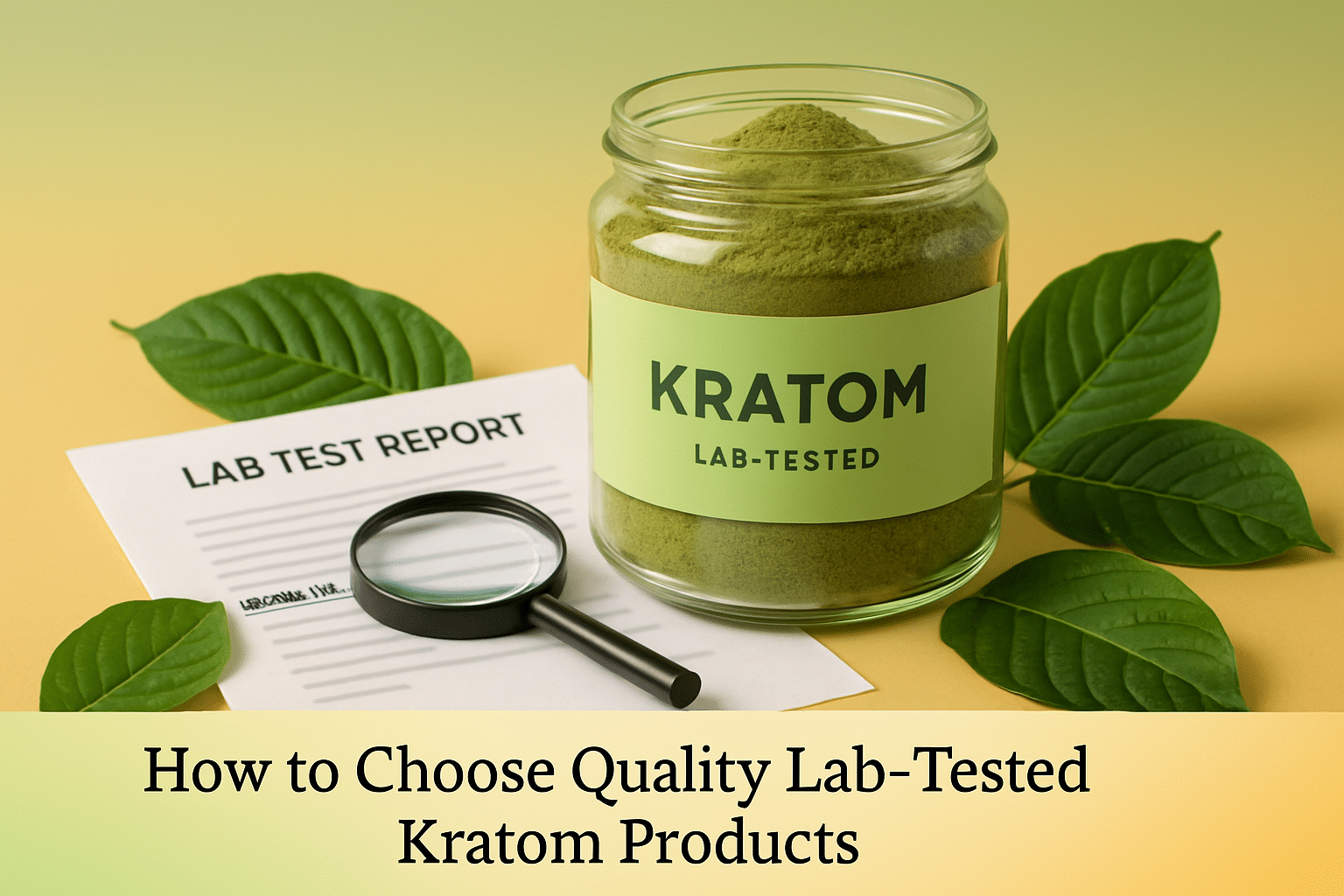
Quality kratom users in Canada face a critical challenge: determining which products meet genuine safety and purity standards. With the kratom market expanding rapidly, lab tested kratom has become the gold standard for ensuring consumer safety and product reliability.
The difference between tested and untested kratom products can impact both safety and effectiveness. Independent laboratory analysis reveals concerning contamination rates, with studies showing that significant percentages of untested kratom fail basic safety screenings. Understanding how to identify legitimate lab tested kratom protects consumers from substandard products while ensuring access to pure, potent botanical materials.
This comprehensive guide examines the essential aspects of kratom testing protocols, quality indicators, and vendor selection criteria that Canadian consumers need to navigate this complex landscape confidently.
Understanding Lab Testing Standards for Kratom Products
Comprehensive Testing Protocols and Industry Standards
Modern kratom testing encompasses multiple analytical procedures designed to verify both safety and potency. Third party kratom testing methods include sophisticated chemical analysis, microbial screening, and alkaloid content verification performed by independent laboratories.
Laboratory testing protocols typically involve high-performance liquid chromatography (HPLC) analysis for alkaloid identification and quantification. Mass spectrometry techniques complement these methods to detect trace contaminants and verify product authenticity. These analytical approaches ensure that lab tested kratom meets established safety benchmarks.
Types of Laboratory Tests: Contaminant Screening and Purity Analysis
Professional kratom testing addresses multiple contamination categories that pose potential risks to consumers. Contaminant screening includes heavy metals, microbial pathogens (E. coli, Salmonella), and pesticides, with alkaloid content analysis for potency verification.
Heavy metal testing specifically targets lead, mercury, cadmium, and arsenic – contaminants that can accumulate in kratom plants grown in polluted soil conditions. Microbial analysis identifies harmful bacteria, yeast, mold, and other pathogens that could compromise product safety. Pesticide residue testing ensures that agricultural chemicals haven’t contaminated the final product.
Reading and Interpreting Certificate of Analysis (COA) Documents
Certificate of Analysis documents serve as the primary evidence of comprehensive testing for any lab tested kratom product. These documents should clearly display specific batch information, testing methodologies, and detailed results for each analytical parameter.
COAs must include batch numbers or lot numbers for traceability, as 15-25% of U.S. kratom fails microbial testing without proper pasteurization. Legitimate COAs feature the testing laboratory’s contact information, accreditation details, and specific detection limits for each tested parameter.
Understanding COA terminology helps consumers evaluate results effectively. Non-detect (ND) readings indicate contaminant levels below detection thresholds. Numerical values should fall within established safety ranges for consumable botanical products.
Key Quality Indicators When Evaluating Lab Tested Kratom
Heavy Metal and Microbial Contamination Screening
Proper contamination screening represents the foundation of quality kratom testing programs. Reputable vendors implement rigorous protocols to identify and eliminate potentially harmful substances before products reach consumers.
Advanced contaminant filtration techniques remove impurities, ensuring products meet safety standards for heavy metals and pathogens. Professional testing laboratories utilize atomic absorption spectrophotometry for heavy metal detection and aerobic plate count methods for microbial analysis.
Acceptable heavy metal limits typically follow international food safety standards. Lead levels should remain below 2.0 ppm, while cadmium, mercury, and arsenic should show non-detect or minimal presence. Microbial testing should demonstrate absence of harmful pathogens and acceptable total bacterial counts.
Alkaloid Content and Potency Verification
Kratom alkaloid potency testing provides essential information about product strength and consistency. Professional laboratories analyze mitragynine and 7-hydroxymitragynine concentrations – the primary active compounds responsible for kratom’s effects.
ISO/IEC 17025:2017 accredited labs analyze mitragynine potency with HPLC-UV methods, achieving stable results in tight ranges (1.22–1.26% mitragynine). This precision enables consumers to make informed decisions about dosage and product selection.
Consistent alkaloid profiles across batches indicate reliable sourcing and processing methods. Variations outside normal ranges may suggest quality control issues or adulteration concerns. Batch specific kratom testing ensures that each lot maintains expected potency levels.
Third-Party Verification and Laboratory Accreditation
Independent laboratory analysis provides unbiased assessment of kratom quality and safety. Third party lab kratom Canada testing eliminates potential conflicts of interest that could arise from internal testing programs.
Accredited laboratories follow strict quality management systems and undergo regular inspections to maintain certification status. ISO certified kratom testing facilities demonstrate compliance with international analytical standards and best practice guidelines.
Look for laboratories that participate in proficiency testing programs and maintain current accreditation from recognized bodies. These credentials indicate that analytical results meet industry standards for accuracy and reliability.
Red Flags to Avoid When Shopping for Tested Kratom Products
Vendors Without Accessible Testing Documentation
Legitimate kratom vendors make testing documentation readily available to customers. Missing or difficult-to-access COAs often indicate insufficient testing protocols or attempts to hide poor product quality.
Labs should provide Certificates of Analysis (COAs) with batch numbers; missing identifiers raise concerns about traceability. Vendors who cannot provide specific batch testing documentation for their current inventory should be approached with caution.
Quality vendors typically display COAs prominently on product pages or provide easy access through QR codes or direct links. Vague testing claims without supporting documentation represent significant red flags for potential customers.
Misleading Marketing Claims and Unsubstantiated Health Benefits
Responsible kratom vendors avoid making unauthorized therapeutic claims about their products. Marketing language that promises specific health benefits or treatment outcomes often indicates non-compliance with regulatory guidelines.
Professional vendors focus on product quality, testing protocols, and botanical characteristics rather than making medical claims. Educational content should emphasize research purposes and botanical properties without suggesting therapeutic applications.
Inconsistent or Outdated Testing Results
Kratom quality control standards require regular testing of new batches to ensure ongoing product safety and consistency. Vendors displaying outdated COAs or testing results from different batches than current inventory raise quality concerns.
Current testing documentation should correspond directly to available product batches. Generic or recycled COAs that don’t match specific lot numbers indicate inadequate quality control procedures.
Choosing Reputable Kratom Vendors in Canada
Compliance with Canadian Regulations and Safety Standards
Reputable kratom vendors Canada understand and comply with relevant federal regulations governing botanical product sales. Proper regulatory compliance demonstrates vendor commitment to legal and ethical business practices.
Kratom cannot be marketed for therapeutic purposes in Canada without Health Canada approval. Legitimate vendors clearly state that their products are intended for botanical research, aromatic, and examination purposes only.
Compliance extends beyond marketing claims to include proper labeling, age restrictions, and transparent business practices. Vendors who operate within established legal frameworks provide additional consumer protection and reliability.
How to Choose Lab Tested Kratom Canada: Essential Vendor Evaluation Criteria
Selecting quality vendors requires evaluation of multiple factors beyond basic testing protocols. Comprehensive vendor assessment includes reviewing business history, customer feedback, and commitment to ongoing quality improvement.
Established vendors typically maintain consistent testing standards across their entire product range. Look for companies that provide detailed information about their sourcing practices, processing methods, and quality control procedures.
Customer service responsiveness and educational resources indicate vendor commitment to consumer satisfaction and safety. Quality vendors invest in customer education and provide knowledgeable support for product-related questions.
|
Vendor Quality Factor |
What to Look For |
Red Flags |
|---|---|---|
|
Testing Documentation |
Current COAs with batch numbers, accredited lab results |
Missing COAs, outdated documents, generic results |
|
Regulatory Compliance |
Clear non-therapeutic labeling, age restrictions |
Health claims, therapeutic promises |
|
Business Transparency |
Contact information, business registration, sourcing details |
Anonymous operations, vague business information |
|
Customer Support |
Knowledgeable staff, educational resources, responsive service |
Limited support, uninformed staff |
Building Long-Term Relationships with Trusted Suppliers
Developing relationships with reliable kratom vendors provides consistent access to quality tested products. Long-term partnerships often result in better customer service, priority access to new products, and improved overall experience.
Trusted vendors value customer feedback and continuously improve their quality standards. They often provide advance notice of new testing results, product availability, and industry developments.
Consider vendors who demonstrate commitment to the kratom community through educational initiatives, transparent business practices, and consistent quality standards. These characteristics typically indicate sustainable business models and long-term reliability.
Making Informed Decisions About Lab Tested Kratom Products
Comparing Testing Standards Across Different Vendors
Not all kratom testing programs meet the same standards of rigor and comprehensiveness. Comparing testing protocols helps consumers identify vendors who prioritize safety and quality over cost reduction.
Comprehensive testing programs analyze multiple parameters including heavy metals, pesticides, microbials, and alkaloid content. Basic testing may only address one or two categories, potentially missing important safety concerns.
Evaluate the frequency of testing, laboratory accreditation status, and scope of analytical parameters when comparing vendors. More comprehensive testing typically indicates higher quality control standards and consumer safety priorities.
Understanding Regional Differences in Testing Requirements
Canadian kratom vendors may follow different testing protocols compared to international suppliers. Understanding these differences helps consumers make informed decisions about product quality and safety.
Some vendors voluntarily exceed minimum requirements by implementing additional testing parameters or higher frequency schedules. These enhanced protocols often reflect commitment to superior quality standards.
Consider vendors who maintain consistent testing standards regardless of regulatory minimums. Voluntary compliance with enhanced testing protocols demonstrates genuine commitment to consumer safety.
Cost Considerations and Value Assessment
Lab tested kratom typically commands higher prices than untested alternatives due to additional quality assurance costs. Understanding the value proposition helps consumers make cost-effective decisions while maintaining safety standards.
Testing costs, laboratory fees, and quality control procedures contribute to final product pricing. Higher prices often reflect more comprehensive testing protocols and superior quality assurance measures.
Evaluate the relationship between price and testing comprehensiveness when comparing products. The lowest-priced options may compromise on testing quality or frequency, potentially impacting consumer safety.
Frequently Asked Questions
What specific tests should lab tested kratom include?
Comprehensive kratom testing should include heavy metal analysis (lead, mercury, cadmium, arsenic), microbial screening (bacteria, yeast, mold, pathogens), pesticide residue detection, and alkaloid content verification. These tests ensure both safety and potency standards are met.
How recent should Certificate of Analysis documents be?
COAs should correspond directly to the specific batch or lot number of kratom being purchased. Testing documentation older than 12 months may not accurately represent current product quality, especially for vendors with high inventory turnover.
Can vendors conduct their own testing instead of using third-party laboratories?
While vendors can perform internal testing, third-party laboratory analysis provides unbiased verification and eliminates potential conflicts of interest. Independent testing typically offers greater credibility and consumer confidence.
What alkaloid percentages indicate high-quality kratom?
Mitragynine content typically ranges from 0.5% to 1.5% in quality kratom, while 7-hydroxymitragynine usually measures below 0.1%. Consistent alkaloid profiles across batches indicate reliable sourcing and processing methods.
How can consumers verify laboratory accreditation status?
Check laboratory websites for current accreditation certificates and contact accrediting bodies directly if needed. ISO/IEC 17025 accreditation represents the gold standard for analytical testing laboratories.
Do all kratom strains require the same testing protocols?
All kratom products should undergo identical safety testing regardless of strain or processing method. Alkaloid profiles may vary between strains, but contamination screening standards remain consistent across all varieties.
Building Confidence Through Informed Kratom Selection
Selecting lab tested kratom requires understanding testing standards, evaluating vendor credentials, and recognizing quality indicators that separate legitimate products from substandard alternatives. Canadian consumers benefit from vendors who prioritize comprehensive testing protocols and transparent business practices.
Quality vendors invest in regular testing, maintain current documentation, and provide educational resources to help consumers make informed decisions. These characteristics typically indicate long-term reliability and commitment to consumer safety.
The kratom industry continues evolving toward higher quality standards and improved testing protocols. Consumers who prioritize lab tested products contribute to this positive development while protecting their own safety and product satisfaction.
Ready to experience premium lab tested kratom? Explore 365 Kratom Canada’s tested collection featuring rigorously analyzed products with comprehensive COAs for every batch.



